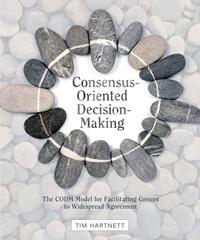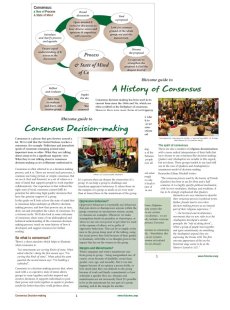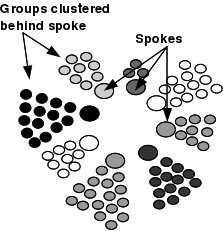 Here’s the second in a series of posts on near-consensus alternatives. In this post we’re talking to Tim Hartnett, facilitator, mediator and counsellor about Consensus Oriented Decision-Making (CODM, pronounced co-dem). Tim has developed CODM and has outlined the method in his recent book Consensus-Oriented Decision-Making: The CODM Model for Facilitating Groups to Widespread Agreement.
Here’s the second in a series of posts on near-consensus alternatives. In this post we’re talking to Tim Hartnett, facilitator, mediator and counsellor about Consensus Oriented Decision-Making (CODM, pronounced co-dem). Tim has developed CODM and has outlined the method in his recent book Consensus-Oriented Decision-Making: The CODM Model for Facilitating Groups to Widespread Agreement.
Tell us a little about CODM – what is it and how does it differ from the consensus decision-making we’re more used to here at Rhizome?
CODM is a seven-step process for building consensus in groups. It provides an outline for facilitators or group members to conduct a participatory and collaborative decision-making process. It could be considered a version of the consensus decision-making model Rhizome members are familiar with, but it offers more detailed guidance on the different stages of the process. CODM combines the basic consensus decision-making model with the best practices of group facilitation, mediation, and nonviolent communication.
One significant difference seems to be the separation of the process of discussion and dialogue and the final decision rule (ie: the agreed mechanism for expressing the will off the group – majority vote, supermajority vote, consensus, unanimity and so on). Can you say a little more about that?
 The CODM model is applicable in groups that require full consent as their final decision rule. But yes, it is also very usable in groups that have other standards of how much agreement is necessary to pass proposals. CODM focuses on consensus as a “process” of group decision-making, and it strives to advance the procedures and techniques of that process so that agreement levels are maximized regardless of what decision rule a group uses.
The CODM model is applicable in groups that require full consent as their final decision rule. But yes, it is also very usable in groups that have other standards of how much agreement is necessary to pass proposals. CODM focuses on consensus as a “process” of group decision-making, and it strives to advance the procedures and techniques of that process so that agreement levels are maximized regardless of what decision rule a group uses.
What drove you to develop CODM? Was it flaws in the current practice and theory of consensus? An attempt to bring consensus to groups for whom formal/simple consensus wouldn’t be appropriate? None of the above?
I teach the CODM model to two main audiences: the general public and those with experience in the formal consensus model. To the general public, I am trying to help groups learn both the value of building consensus and the tools for a successful consensus process. CODM is a model that can be applied to a great variety of groups, large and small, diverse or cohesive. So it is a model that can bring consensus decision-making into much wider use.
Is that primarily because of CODM’s flexibility around the decision rule?
CODM makes consensus-oriented decision-making applicable to a wide variety of groups not only because it offers flexibility around decision rules. Just as importantly, it gives detailed steps for how to successfully conduct a collaborative discussion. The basic consensus model offers only the vague steps of discuss objections, make modifications, and re-test for consensus. The CODM model articulates these tasks into much greater detail, making the model easier to understand and use.
You were telling us about your two audiences…
To groups already familiar with the formal consensus model I offer CODM as a way to help hone group process for greater success. The detailed steps can clarify the path to consensus. They provide a template for facilitators, a backbone structure to improvise from as you facilitate each unique situation.
I also enjoy helping groups identify when the formal consensus model may be negatively affecting their group dynamic. In such cases, CODM can help a group regain efficient functionality, while retaining a consensus process. I have seen some very well-intentioned groups suffer (and even disband) because of dynamics related to their version of consensus. So it has been very gratifying to be able to help such groups become more flexible and begin to thrive again.
So the detail in CODM supports us to be more rigorous in our practice of consensus with groups?
Yes, CODM helps groups to be more successful using consensus. Thus, groups can more rigorously use the process. When groups have trouble using consensus, they often slide into using alternatives. Sometimes, for instance, a group will form a steering committee to handle many decisions because it too difficult for the whole group to conduct an (often chaotic) consensus process on multiple issues. But if a group has a more clear and efficient process, they can continue to practice whole group decision-making, and not delegate that authority to a steering committee.
There are many other ways groups that struggle succeeding with consensus begin to make decisions outside of an honest group consensus process. For instance, an ethos of people “doing their own thing” may evolve. While this might support individual autonomy, it may also be a result of unsuccessful attempts to cooperate. A more effective process can help a group bring more issues to a true consensus.
Can you give us an example of CODM working to its full potential so we can get a feel for the challenges it can help a group deal with, and the kind of groups using it?
One group asked me to facilitate an important meeting wherein a proposal to change the group by-laws was to be presented. A subcommittee had drafted new by-laws, and they intended to follow a formal consensus process to gain the group’s approval. They planned to present the proposal, answer questions and then adapt it in response to feedback. But they were very worried that some members of the group would be resistant to the whole idea. Prior to the meeting there were already people talking about blocking the committee’s proposal. I suggested that the group use the CODM model instead. The CODM steps offered three valuable contributions that I think proved very useful.
First, we started with an open discussion that articulated all of the needs that new by-laws might hope to address. This gave the group members a chance to understand all the concerns that needed to be addressed prior to presenting any proposal.
Second, when it came time to begin developing a proposal, the CODM process offered a way for options to be developed collaboratively. As different group members contributed ideas, the resulting proposal was a joint project, owned by the whole group, and not the work of a subcommittee. This lessened the resistance some members were feeling about being shut out of the development process. It is true that many of the ideas originated from the subcommittee’s draft. But the CODM process allowed them to be pieced together in a way that gave everyone a sense of ownership. Each part of the newly proposed by-laws were also directly related to needs the group had identified, giving everyone a shared understanding of the rationale for each item.
And finally, the CODM process guided the group to develop several alternatives. For instance, there were two versions of proposed requirements for official group membership (should there be an “inactive” membership status?). The group considered each of these versions in turn, brainstorming how the drawbacks of each might be successfully addressed. This kept the group working together, trying to improve each option, one at a time. Only after this was complete did the group start evaluating which option better met the needs of the whole group. Delaying the evaluation phase helped the discussion avoid becoming adversarial. Everyone understood the potential of each idea before anyone started comparing them.
In the end, the feared resistance to new by-laws never materialized. The CODM process prevented an adversarial dynamic from developing between the subcommittee and other group members. It shepherded the group toward a decision that everyone understood and felt ownership toward. The result was not only full agreement, but a fully collaborative process.
I have to ask: what have been the biggest problems you’ve encountered with CODM?
The biggest challenge people have in using CODM is assessing whether or not to use short-cuts to the process. Not all decisions require full consideration of several alternatives before a decision is made. The CODM model encourages the use of short-cuts whenever the group desires to move more quickly through the steps. Sometimes, however, it can be difficult to know when it will work to speed through a step and when more diligence will prevent problems later in the process. For instance, the full CODM process calls for posting a complete list of identified stakeholder needs and concerns. With major decisions, such a list can keep everyone fully aware of the criteria for a successful outcome. But if the list is short and relatively obvious, then putting it up on a poster may be overkill. If you know the CODM process well, you begin to get a stronger intuition about when short-cuts can be taken successfully.
Perhaps the most common critique of consensus, from its friends as well as it’s foes, is that it’s too time-consuming to be practicable. What’s your experience of CODM – appreciating that there are some short cuts, what can we expect in terms of how long it takes, compared to groups working by formal consensus?
As you mention, groups using CODM are encouraged to use short-cuts as necessary for them to reach the desired balance between time efficiency and thorough deliberation. When the full process is employed, competing proposals are developed one at a time. This may take more time up front, but it shortens the time needed to choose between proposals later, because it ensures that each option is well understood before it is decision time. An aggravating waste of time in many meetings occurs when people argue against proposals they don’t really understand yet. CODM can successfully prevent this. But if the CODM process is used more thoroughly than necessary, a group may spend time on steps that an appropriate short-cut would avoid. That is a danger when a facilitator is first learning to use CODM and is not able to assess when a short-cut might be advantageous.
From a facilitators perspective what are the other main challenges of facilitating CODM? For those of us used to formal/simple consensus how would we need to adapt our facilitation?
Those familiar with formal/simple consensus facilitation can gain two valuable things from CODM without needing to change the style or tone of their role as facilitator. First, CODM will give them a stronger understanding of the building blocks of real collaboration. It is like learning music theory after having learned to play music by ear. You may do many of the same things you always have. But you will better understand what to do when things start falling apart. And you will have more tools up front to prevent the common problems in group deliberations.
Secondly, the CODM model is defined by the process it outlines, not the decision rule a group uses to complete its decisions. There is an important distinction between a consensus “process” and a full-consent “decision rule”. Some facilitators have a hard time loosening the ideology that has invariably wed these two concepts. The fact that we use the word “consensus” to refer to both the process and the outcome does not help. But when facilitators begin to think flexibly about this distinction they increase their ability to help a greater variety of groups in a greater variety of situations.
Help us loosen that ideology. What’s your experience: do you feel that groups using the CODM process and then a voting decision rule are reaching decisions that are as deeply collaborative as the consensus groups you’ve worked with (and by that I mean those that use consensus process and decision rule)? Does the vote become more of a formality because the process has forged deep agreement?
 My experience is that a good process is what generates that wonderful, organic sense of “we don’t even need to vote, because the answer is clear to us all.” I have seen that good process (and the resulting harmony) occur in groups with all different kinds of decision rules. And I have witnessed some awful process in all types of groups as well. That’s what confirms for me that how you discuss things is ultimately more important than whether you require full consent.
My experience is that a good process is what generates that wonderful, organic sense of “we don’t even need to vote, because the answer is clear to us all.” I have seen that good process (and the resulting harmony) occur in groups with all different kinds of decision rules. And I have witnessed some awful process in all types of groups as well. That’s what confirms for me that how you discuss things is ultimately more important than whether you require full consent.
I enjoyed the book and am learning from it. I’ve already changed my thinking about consensus. But it was the final chapter of the book “Going for full agreement” that I found most challenging and interesting. You offer some well-honed critiques of a unanimous approach to decision-making. Can you say a bit about that?
Those who believe that requiring full consent is the ideologically superior decision rule in all cases will be challenged by the observations I make in this chapter. Their sacred cow is examined quite closely. In all fairness, the book should include a similar chapter on the drawbacks of adversarial debate. It does not, simply for the reason that most people interested in consensus decision-making already understand these problems. But unfortunately, not everyone practicing consensus decision-making understand the problems that requiring full consent can create for a group that cannot achieve it successfully.
My overarching goal is to help groups make decisions as collaboratively and as efficiently as they need to function well. When a group can successfully reach full agreement, requiring it can work fine, and the CODM model can help ensure success. When groups are larger, more diverse, pressed for time, or otherwise challenged, the full consent rule has presented some real problems. I think it is important to honestly assess these difficulties. Sometimes changing the group’s decision rule can solve problems that otherwise threaten a group’s survival. The CODM model offers a way to be flexible in final decision rules while still employing a consensus-oriented deliberation process.
One of the things that stands out for me throughout this chapter is the language of ‘voting’ that you use throughout. Let me give you an example – you talk about the possibility that for some people some of the time holding true to their own opinion and being outvoted in a majority vote situation can be more satisfying than consensus, because they get to hold to their own view whereas in consensus they’re asked/expected to vote to help form a group view. Many consensus facilitators would say that consensus has no element of voting, of mine versus yours, it’s about co-operation through and through….
Voting is simply the act of having each group member indicate their preference in some way. There is nothing inherently competitive about it. It is just a way to gather information. Unfortunately, the discourse on consensus has often contrasted “voting” with “consensus” as if the “test for consensus” is not a form of voting. The legitimate contrast is between the different decision rules: majority vote, super-majority, full consent, etc. A common fallacious contrast, however is often made between “majority voting” and “consensus process”. This pairing contrasts a decision rule with a dialogue/deliberation process, an apple and an orange. It is more clear to contrast fruits of the same kind.
“Majority voting” and “requiring full consent” are both decision rules. Groups can and should contrast these options to find the one that works best for them. I am neutral on this topic unless I see that a group is unable to successfully use the decision rule they have chosen. If majority rule decisions are undermined by the minority, there is a problem. Likewise, if a group can’t move forward on popular ideas that need action, there is also a problem. The problem may be solvable by improving the process. If not, the problem may be addressed by changing the decision rule.
“Consensus process” and “adversarial debate” are both dialogue/deliberation processes. Most of the criticisms leveled at “majority rule” are really criticisms of “adversarial debate”. In this contrast I am not neutral. I advocate that a consensus process be used as much as possible. While there is some value to adversarial debate, I believe all of its goals can be better achieved with a cooperative approach.
So the choices a group needs to make are: one, do we use a consensus-oriented process or an adversarial process; and two, at the end of our discussion how do we finalize decisions (with a vote requiring which threshold of agreement or consent)? These two choices can be made independently. For instance, a group may use a consensus-oriented process paired with a majority vote. Likewise, a group could engage in prolonged adversarial debate, conducted in search of satisfying a requirement for full consent to pass proposals. The chosen decision rule does not dictate the conduct of the process. And voting (whether you tally “agreement” or “consent”) occurs regardless.
You might also like to read:
Near-consensus alternatives: Crowd Wise
















